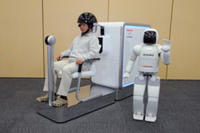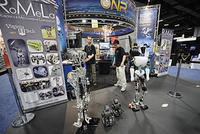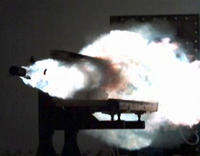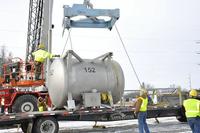-
U.S. Navy experience shows climate alterations
The U.S. Navy reports that because of its worldwide presence, it sees the effects of climate change directly; and expert tells a scientific audience at Sandia Lab that disparities in current climate science projections “mean that the Navy should plan for a range of contingencies, given our limited ability to predict abrupt change or tipping points for potentially irreversible change”
-
-
Test strip detects TNT and other explosives in water
Scientists developed a new explosives detector that can sense small amounts of TNT and other common explosives in liquids instantly with a sensitivity that rivals bomb-sniffing dogs, the current gold standard in protecting the public from terrorist bombs
-
-
Army scientists work to improve biothreat detection
A married couple, both scientists working at the U.S. Army’s Edgewood Chemical Biological Center, one of forty-five Biosafety Level 3 labs in the United States; they collaborate on improving the ability of soldiers and first responders to detect, identify, and protect against potentially lethal biological threat agents
-
-
Pentagon explores mind-controlled battle robots

Taking a page from the popular movie Avatar, the military’s advanced research arm DARPA is seeking to develop technology that would allow troops to remotely inhabit the bodies of mechanical androids on the battlefield
-
-
NASA official says hackers gained “full functional control”
Last week NASA officials disclosed details about the alarming extent that hackers were able to penetrate the agency’s networks
-
-
Robot for shipboard firefighting

In both war and peace, fire in the shipboard environment is serious and frequently results in excessive damage and high repair costs because the fire is not detected or controlled adequately; researchershave developed a humanoid robot that could fight fires on the next generation of combatants
-
-
DARPA sponsors development of deep-sea surveillance robot
New Unmanned Underwater Vehicles (UUVs) to address Anti-Submarine Warfare (ASW) surveillance needs over large, operationally demanding areas
-
-
Growing use of IEDs by anti-government insurgents in Syria
The monthly number of IEDs reported in Syria jumped 134 percent from December to January; analysts say this is an indication of foreign involvement with the rebels
-
-
U.S. Navy tests electromagnetic railgun launcher

The electromagnetic railgun launcher is a long-range weapon that fires projectiles using electricity instead of chemical propellants; magnetic fields created by high electrical currents accelerate a sliding metal conductor, or armature, between two rails to launch projectiles at 4,500 mph to 5,600 mph; the new railgun will allow the U.S. Navy to conduct precise, long-range naval surface fire support for land strikes, ship self-defense against cruise and ballistic missiles, and surface warfare to deter enemy vessels
-
-
Detecting explosives from a distance with laser beams
Scientists have found a way to detect chemicals over long distances, even if they are enclosed in containers; the scientists tested the system by trying to detect frequently used explosives, such as TNT, ANFO, or RDX from a distance – and the tests were successful
-
-
Rats trained to detect explosives
Bomb sniffing dogs could be a thing of the past thanks to explosives seeking rats; unlike dogs, when rats detect sensitive explosives like land mines they rarely set them off as they weigh less than pound
-
-
SOUTHCOM deploys radar that sees through foliage, rain, darkness, and dust storms
Lockheed Martin’s TRACER is a light weight, low-frequency synthetic-aperture radar that can peer through foliage, rain, darkness, dust storms, or atmospheric haze to provide real-time, high-quality tactical ground imagery; U.S. Southern Command has just deployed the penetrating radar to support the Command’s counter-terrorism and humanitarian assistance missions, and disaster relief operations
-
-
End of Utah’s chemical weapons stockpile signals end of federal grants

As the last of Utah’s chemical weapons stockpile is destroyed, the millions of dollars that have flowed into the state from federal grants will begin to disappear along with thousands of jobs
-
-
One in three of military aircraft are drones
A report by the Congressional Research Service (CRS) recently made public reveals that unmanned drones now account for 31 percent of all military aircraft
-
-
In Keene, N.H., locals oppose military equipment for police
With the help of a $285,933 DHS grant, local police in Keene, New Hampshire were all set to purchase a new armored vehicle until local residents got wind of the plan; the citizens of the quiet New Hampshire town of 23,000, which has only seen two murders since 1999, questioned why police needed such an expensive military-type truck and balked at the militarization of a local force; with federal counterterrorism money continuing to pour into local communities, lawmakers and residents across the country will have to grapple with the same issues as Keene and determine what kind of police force they want to have patrolling the streets
-
More headlines
The long view
Tantalizing Method to Study Cyberdeterrence
Tantalus is unlike most war games because it is experimental instead of experiential — the immersive game differs by overlapping scientific rigor and quantitative assessment methods with the experimental sciences, and experimental war gaming provides insightful data for real-world cyberattacks.
Testing Cutting-Edge Counter-Drone Technology
Drones have many positive applications, bad actors can use them for nefarious purposes. Two recent field demonstrations brought government, academia, and industry together to evaluate innovative counter-unmanned aircraft systems.
European Arms Imports Nearly Double, U.S. and French Exports Rise, and Russian Exports Fall Sharply
States in Europe almost doubled their imports of major arms (+94 per cent) between 2014–18 and 2019–23. The United States increased its arms exports by 17 per cent between 2014–18 and 2019–23, while Russia’s arms exports halved. Russia was for the first time the third largest arms exporter, falling just behind France.
How Climate Change Will Affect Conflict and U.S. Military Operations
“People talk about climate change as a threat multiplier,” said Karen Sudkamp, an associate director of the Infrastructure, Immigration, and Security Operations Program within the RAND Homeland Security Research Division. “But at what point do we need to start talking about the threat multiplier actually becoming a significant threat all its own?”
The Tech Apocalypse Panic is Driven by AI Boosters, Military Tacticians, and Movies
From popular films like a War Games or The Terminator to a U.S. State Department-commissioned report on the security risk of weaponized AI, there has been a tremendous amount of hand wringing and nervousness about how so-called artificial intelligence might end up destroying the world. There is one easy way to avoid a lot of this and prevent a self-inflicted doomsday: don’t give computers the capability to launch devastating weapons.
